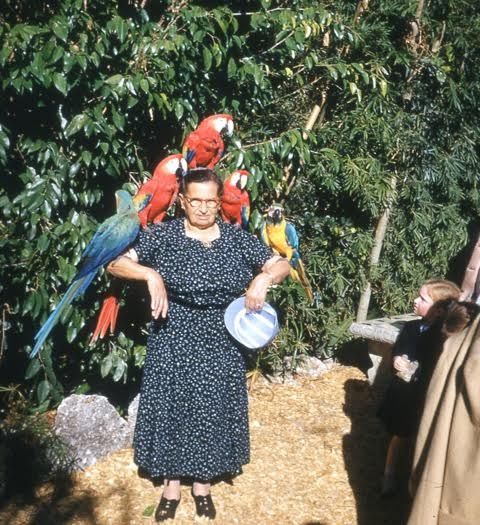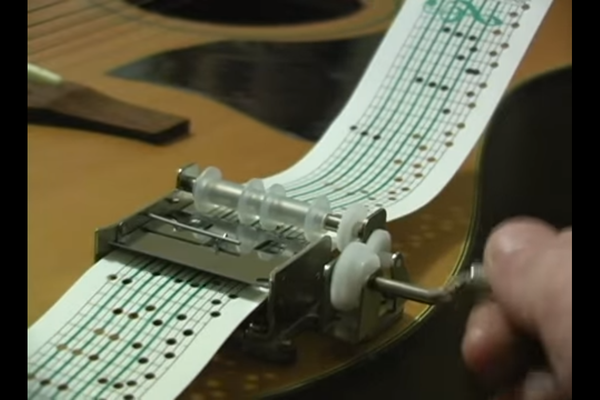Inside a Comedy Writer’s Treasure Trove of Mid-Century 3-D Photos
Eric Drysdale’s stereoscopic collection plunks you right down in the middle of the 1950s.

A stereoscopic camera, with people around viewing slides. (All photos: Atlas Obscura)
The scene is very 2016—eight of us together in a room, each completely absorbed in what’s happening inside our goggles. One of us inhales with wonder; another lets out a murmured “wow.” Our host, Eric Drysdale, walks around checking on us—our sky-high eyebrows, our slackened jaws, our fingers clamped around our viewers. “Remember to focus,” he says, gently.
Our goggles aren’t a futuristic silver or black, or even a sleek 21st-century white. They don’t have touchpads or charge cords. They’re matte red, made of glass and plastic, with just one toy-sized button on top. When Drysdale tells us to focus, he’s not chiding our concentration—he’s reminding us that in order to get the best view of our slides, we need to literally turn a knob on the side. And by looking through them, we’re plunging ourselves not into some invented world, but into midcentury America, as seen through the lenses of the three-dimensional stereoscopic viewer, hero of a beautiful and forgotten photography craze.

A stereoscope slide, showing synchronized swimmers.
Stereoscopic photography is pretty simple: instead of taking one picture, a stereo camera takes two, through lenses spaced approximately as far apart as human eyes. The pictures are then made into a slide, and viewed through a two-eyed viewer. When your eyes work together to combine the pictures, they create the illusion of depth. Cameras, slides and viewers were widely available throughout the 1950s and ’60s, but then faded in popularity, phased out in favor of cameras that provided more public viewing possibilities.
Drysdale has been collecting stereoscopic equipment since 1994, when he stumbled across some slides and a viewer while cleaning out a closet in his wife’s grandmother’s apartment. He had always been interested in immersive viewing—as a kid, “I used to take red and blue crayons and try to draw things in 3D,” he says—so he had an idea of what he had come across. He paused the cleanup efforts, brought his finds downstairs, and rooted around for the necessary batteries.

Drysdale’s wife’s great-great-grandmother, at Parrot Jungle. Drysdale first viewed this image in sterescope. (Photo: Eric Drysdale)
As soon as he loaded a slide and pressed the button, he was hooked. One of the first images he saw was the one above: “That’s my wife’s great-great-grandmother, straight from the shtetl in Russia, at Parrot Jungle with six parrots all over her, her arms outstretched,” he says. “It was just such a distinct postwar moment … It was shocking in a wonderful way.”
Thus begun a two-decade hunt for slides and equipment (he used to hit up flea markets; now he trawls eBay). In this way, he’s amassed his own historic archive—tens of thousands of all-American slices of life, preserved, as he puts it, in “punch-you-in-the-face 3-D.”
As with all technologies, steresccopic photography developed some niche uses—coffin salesmen loved it because it conveyed a sense of size, and so, inevitably, did pornographers. But many enthusiasts were hobbyists, members of America’s robust middle class seeking to document their lives. As Drysdale explains, “these are pictures of the things you take pictures of—road trips, first haircuts, birthday parties.” They’d bring the camera along to a bar mitzvah, or to Parrot Jungle. Later, they’d pull the slide boxes out instead of watching television—passing around the viewer, laughing or sighing over what they’d gotten up to.

Drysdale fixes a broken viewer.
Drysdale, a comedy writer, is used to being the thing in the living room that makes you laugh. He’s won Emmys, and has worked on the Daily Show and The Colbert Report (Colbert fans might remember him as “Bobby,” Stephen’s much-beleagured stage manager). But despite these years behind the scenes and under the lights, he prefers to let the photographs speak for themselves.
For this show, at the PRX Podcast Garage in Allston, MA, he turns on peppy ’50s tunes, and encourages people to sprawl out on the room’s beanbag chairs. He hands out themed slide boxes—“Swimming Pools”; “Portraits”; “Jewish Ceremonies and Celebrations”—each of which he has carefully curated. “I will act as your slide sommelier,” he says, making sure everyone has a chance to see everything. You’d be hard pressed to find someone more quietly excited to show you a 3-D scene from a 1950s bar mitzvah.

This slide shows a dragon balloon from an early Macy’s Thanksgiving Day Parade.
The excitement is quickly infectious. Outside the viewer, sterescopic images look like microscope slides—the labels and colors may intrigue, but the pictures are too small to appreciate. It’s somewhat easy to imagine returning them to the box, and stuffing them back into the closet. Inside the viewer, though, they transform. The colors are rich, almost palpable. The depth is effective but not distracting, pulling you into the scene rather than popping out at you.
One attendee compares the experience to being in a tiny cinema: a whole, suggestive world, framed by blackness. “I feel like the people are breathing,” says another. While viewing one slide, of two young boys overwhelmed by Coney Island, I catch myself craning my neck, trying to peer around a pole to read a marquee. Pigeons on a Manhattan street seem close enough to trip over. Stories come to mind about the first movies—how people, upon seeing the Lumiere Brothers’ film from a railroad station, ran away from what they were sure was a real train.

Guests look through viewers.
Some of this magic is purely technological—the ease with which the eye adapts, and the depth of color in the Kodachrome film (which won’t fade for decades yet, and which Drysdale says is “the most archival film ever made”). But there’s also a certain immersion not wholly explained by the 3D. As atmospheric as old technologies are, the history they carry can put layers in between us and them—the dimming of old Polaroids, the black and white of archival footage, or even, in films and recordings, the strange cadences of past forms of speech.
In the stereoscope, none of that is present. “The piece of film you’re looking at was in the room when the picture was taken,” Drysdale reminds us, quietly, as we’re looking. Later, I realize this is true of most film. But with stereoscope, you really feel it—and you feel like you were there too.
















Follow us on Twitter to get the latest on the world's hidden wonders.
Like us on Facebook to get the latest on the world's hidden wonders.
Follow us on Twitter Like us on Facebook